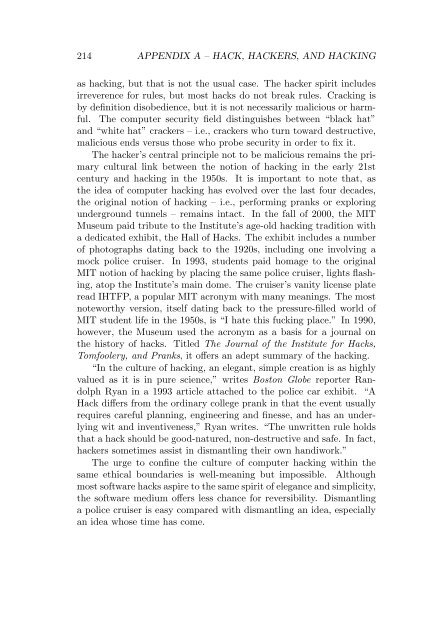You also want an ePaper? Increase the reach of your titles
YUMPU automatically turns print PDFs into web optimized ePapers that Google loves.
214 APPENDIX A – HACK, HACKERS, AND HACKING<br />
as hacking, but that is not the usual case. The hacker spirit includes<br />
irreverence for rules, but most hacks do not break rules. Cracking is<br />
by definition disobedience, but it is not necessarily malicious or harmful.<br />
The computer security field distinguishes between “black hat”<br />
and “white hat” crackers – i.e., crackers who turn toward destructive,<br />
malicious ends versus those who probe security in order to fix it.<br />
The hacker’s central principle not to be malicious remains the primary<br />
cultural link between the notion of hacking in the early 21st<br />
century and hacking in the 1950s. It is important to note that, as<br />
the idea of computer hacking has evolved over the last four decades,<br />
the original notion of hacking – i.e., performing pranks or exploring<br />
underground tunnels – remains intact. In the fall of 2000, the MIT<br />
Museum paid tribute to the Institute’s age-old hacking tradition with<br />
a dedicated exhibit, the Hall of Hacks. The exhibit includes a number<br />
of photographs dating back to the 1920s, including one involving a<br />
mock police cruiser. In 1993, students paid homage to the original<br />
MIT notion of hacking by placing the same police cruiser, lights flashing,<br />
atop the Institute’s main dome. The cruiser’s vanity license plate<br />
read IHTFP, a popular MIT acronym with many meanings. The most<br />
noteworthy version, itself dating back to the pressure-filled world of<br />
MIT student life in the 1950s, is “I hate this fucking place.” In 1990,<br />
however, the Museum used the acronym as a basis for a journal on<br />
the history of hacks. Titled The Journal of the Institute for Hacks,<br />
Tomfoolery, and Pranks, it offers an adept summary of the hacking.<br />
“In the culture of hacking, an elegant, simple creation is as highly<br />
valued as it is in pure science,” writes Boston Globe reporter Randolph<br />
Ryan in a 1993 article attached to the police car exhibit. “A<br />
Hack differs from the ordinary college prank in that the event usually<br />
requires careful planning, engineering and finesse, and has an underlying<br />
wit and inventiveness,” Ryan writes. “The unwritten rule holds<br />
that a hack should be good-natured, non-destructive and safe. In fact,<br />
hackers sometimes assist in dismantling their own handiwork.”<br />
The urge to confine the culture of computer hacking within the<br />
same ethical boundaries is well-meaning but impossible. Although<br />
most software hacks aspire to the same spirit of elegance and simplicity,<br />
the software medium offers less chance for reversibility. Dismantling<br />
a police cruiser is easy compared with dismantling an idea, especially<br />
an idea whose time has come.


